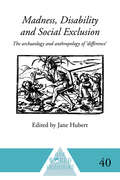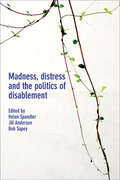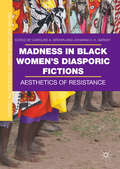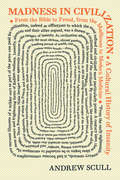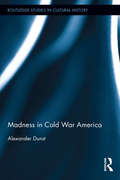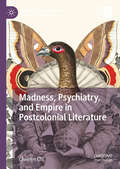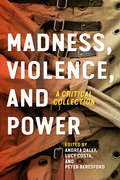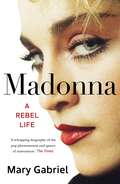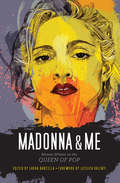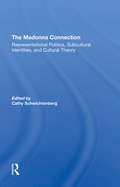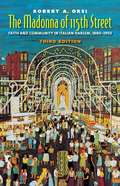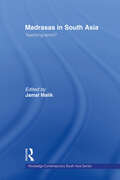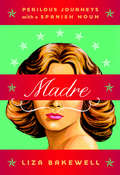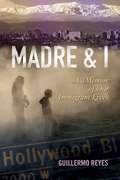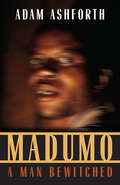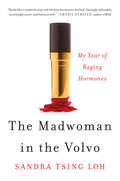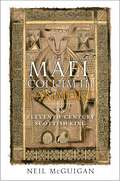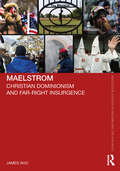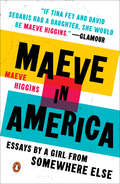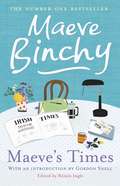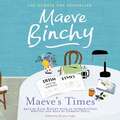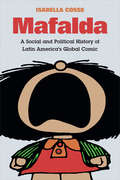- Table View
- List View
Madness, Disability and Social Exclusion: The Archaeology and Anthropology of 'Difference' (One World Archaeology #Vol. 40)
by Jane HubertA unique work that brings together a number of specialist disciplines, such as archaeology, anthropology, disability studies and psychiatry to create a new perspective on social and physical exclusion from society. A range of evidence throws light on such things as the causes and consequences of social exclusion stigma, marginality and dangerousness.It is an important text that breaks down traditional academic disciplinary boundaries and brings a much needed comparative approach to the subject.
Madness, Distress and the Politics of Disablement
by Helen Spandler, Jill Anderson and Bob SapeyThis book explores the challenges of applying disability theory and policy, including the social model of disability, to madness and distress. It brings together leading scholars and activists from Europe, North America, Australia and India, to explore the relationship between madness, distress and disability. Whether mental health problems should be viewed as disabilities is a pressing concern, especially since the inclusion of psychosocial disability in the UN Convention on the Rights of Persons with Disabilities. This book will appeal to policy makers, practitioners, activists and academics.
Madness in Black Women’s Diasporic Fictions
by Caroline A. Brown Johanna X. K. GarveyThis collection chronicles the strategic uses of madness in works by black women fiction writers from Africa, the Caribbean, Canada, Europe, and the United States. Moving from an over-reliance on the "madwoman" as a romanticized figure constructed in opposition to the status quo, contributors to this volume examine how black women authors use madness, trauma, mental illness, and psychopathology as a refraction of cultural contradictions, psychosocial fissures, and political tensions of the larger social systems in which their diverse literary works are set through a cultural studies approach. The volume is constructed in three sections: Revisiting the Archive, Reinscribing Its Texts: Slavery and Madness as Historical Contestation, The Contradictions of Witnessing in Conflict Zones: Trauma and Testimony, and Novel Form, Mythic Space: Syncretic Rituals as Healing Balm. The novels under review re-envision the initial trauma of slavery and imperialism, both acknowledging the impact of these events on diasporic populations and expanding the discourse beyond that framework. Through madness and healing as sites of psychic return, these novels become contemporary parables of cultural resistance.
Madness in Civilization
by Andrew ScullThe loss of reason, a sense of alienation from the commonsense world we all like to imagine we inhabit, the shattering emotional turmoil that seizes hold and won't let go--these are some of the traits we associate with madness. Today, mental disturbance is most commonly viewed through a medical lens, but societies have also sought to make sense of it through religion or the supernatural, or by constructing psychological or social explanations in an effort to tame the demons of unreason. Madness in Civilization traces the long and complex history of this affliction and our attempts to treat it.Beautifully illustrated throughout, Madness in Civilization takes readers from antiquity to today, painting a vivid and often harrowing portrait of the different ways that cultures around the world have interpreted and responded to the seemingly irrational, psychotic, and insane. From the Bible to Sigmund Freud, from exorcism to mesmerism, from Bedlam to Victorian asylums, from the theory of humors to modern pharmacology, the book explores the manifestations and meanings of madness, its challenges and consequences, and our varied responses to it. It also looks at how insanity has haunted the imaginations of artists and writers and describes the profound influence it has had on the arts, from drama, opera, and the novel to drawing, painting, and sculpture.Written by one of the world's preeminent historians of psychiatry, Madness in Civilization is a panoramic history of the human encounter with unreason.
Madness in Cold War America: Mad America (Routledge Studies in Cultural History)
by Alexander DunstThis book tells the story of how madness came to play a prominent part in America’s political and cultural debates. It argues that metaphors of madness rise to unprecedented popularity amidst the domestic struggles of the early Cold War and become a pre-eminent way of understanding the relationship between politics and culture in the United States. In linking the individual psyche to society, psychopathology contributes to issues central to post-World War II society: a dramatic extension of state power, the fate of the individual in bureaucratic society, the political function of emotions, and the limits to admissible dissent. Such vocabulary may accuse opponents of being crazy. Yet at stake is a fundamental error of judgment, for which madness provides welcome metaphors across US diplomacy and psychiatry, social movements and criticism, literature and film. In the process, major parties and whole historical eras, literary movements and social groups are declared insane. Reacting against violence at home and war abroad, countercultural authors oppose a sane madness to irrational reason—romanticizing the wisdom of the schizophrenic and paranoia’s superior insight. As the Sixties give way to a plurality of lifestyles an alternative vision arrives: of a madness now become so widespread and ordinary that it may, finally, escape pathology.
Madness, Psychiatry, and Empire in Postcolonial Literature (Palgrave Studies in Literature, Science and Medicine)
by Chienyn ChiMadness, Psychiatry, and Empire in Postcolonial Literature provides a comparatist interrogation of empire through archives of history, science, and literature. The book analyzes Aimé Césaire’s Discourse on Colonialism to shed light on Césaire’s critique of psychological and medical discourses of the colonized’s mind. The book argues that the discourse of psychiatry, psychology, and psychoanalysis has erased the context of power in global histories of empire. Through the book’s chapters, Chi analyzes Lu Xun’s “A Madman’s Diary,” Virginia Woolf’s Mrs. Dalloway, and Tsitsi Dangarembga’s Nervous Conditions to assert that the misapprehension of madness should not automatically be accepted as the history of an isolated Western culture but rather that of the history of imperialism—a globalizing process that silences alternative cultural conceptions of the mind, of madness, and of behavior, as well as different interpretations of madness.
Madness, Violence, and Power: A Critical Collection
by Peter Beresford Lucy Costa Andrea DaleyMadness, Violence, and Power: A Critical Collection disengages from the common forms of discussion about violence related to mental health service users and survivors which position those users or survivors as more likely to enact violence or become victims of violence. Instead, this book seeks to broaden understandings of violence manifest in the lives of mental health service users/survivors, ‘push’ current considerations to explore the impacts of systems and institutions that manage ‘abnormality’, and to create and foster space to explore the role of our own communities in justice and accountability dialogues. This critical collection constitutes an integral contribution to critical scholarship on violence and mental illness by addressing a gap in the existing literature by broadening the “violence lens,” and inviting an interdisciplinary conversation that is not narrowly biomedical and neuro-scientific.
Madonna: A Rebel Life - The Biography
by Mary GabrielIn this exceptional biography, Pulitzer Prize finalist Mary Gabriel chronicles the meteoric rise and enduring influence of the greatest female pop icon of the modern era: Madonna.'Daring to write a biography of a woman with whom the entire world is on a first-name basis, Mary Gabriel has created (astonishingly) a book neither gossip-driven nor highly snarky... she reveals instead a Madonna both more true and more unbelievably believable; a rock-and-roll suffragette... Norman Mailer once said to Madonna, 'I've come to the conclusion that you are a great artist.' Exquisitely detailed in her storytelling, Gabriel is clearly in that camp, convincing us that we all still vogue in the House of Madonna.'Brad Gooch, author of City Poet With her arrival on the music scene in the early 1980s, Madonna generated nothing short of an explosion - as great as that of Elvis or the Beatles - taking the nation by storm with her liberated politics and breathtaking talent. But Madonna was more than just a pop star. Everywhere, fans gravitated to her as an emblem of a new age, one in which feminism could shed the buttoned-down demeanour of the 1970s and feel relevant to a new generation. Amid the scourge of AIDS, she brought queer identities into the mainstream, fiercely defending a person's right to love whomever - and be whoever - they wanted. Despite fierce criticism, she never separated her music from her political activism. And as an artist, she never stopped experimenting. Madonna existed to push past boundaries by creating provocative, visionary music, videos, films and live performances that changed culture globally. Deftly tracing Madonna's story from her Michigan roots to her rise to super-stardom, master biographer Mary Gabriel captures the dramatic life and achievements of one of the greatest artists of our time.
Madonna: A Rebel Life - The Biography
by Mary Gabriel'A whopping biography of the pop phenomenon and queen of reinvention. Life is a mystery - hers oughtn't to be after reading this.' THE TIMES, ' biggest books for autumn''A fascinating take on one of music's greatest icons' BELFAST TELEGRAPHIn this exceptional biography, Pulitzer Prize finalist Mary Gabriel chronicles the meteoric rise and enduring influence of the greatest female pop icon of the modern era: Madonna.'Daring to write a biography of a woman with whom the entire world is on a first-name basis, Mary Gabriel has created (astonishingly) a book neither gossip-driven nor highly snarky... she reveals instead a Madonna both more true and more unbelievably believable; a rock-and-roll suffragette... Norman Mailer once said to Madonna, 'I've come to the conclusion that you are a great artist.' Exquisitely detailed in her storytelling, Gabriel is clearly in that camp, convincing us that we all still vogue in the House of Madonna.'Brad Gooch, author of City Poet With her arrival on the music scene in the early 1980s, Madonna generated nothing short of an explosion - as great as that of Elvis or the Beatles - taking the nation by storm with her liberated politics and breathtaking talent. But Madonna was more than just a pop star. Everywhere, fans gravitated to her as an emblem of a new age, one in which feminism could shed the buttoned-down demeanour of the 1970s and feel relevant to a new generation. Amid the scourge of AIDS, she brought queer identities into the mainstream, fiercely defending a person's right to love whomever - and be whoever - they wanted. Despite fierce criticism, she never separated her music from her political activism. And as an artist, she never stopped experimenting. Madonna existed to push past boundaries by creating provocative, visionary music, videos, films and live performances that changed culture globally. Deftly tracing Madonna's story from her Michigan roots to her rise to super-stardom, master biographer Mary Gabriel captures the dramatic life and achievements of one of the greatest artists of our time.
Madonna and Me: Women Writers on the Queen of Pop
by Jessica Valenti Laura BarcellaFor nearly 30 years, Madonna has been at the center of the media spotlight. She has sold more than 200 million records worldwide, launched her own record label, headlined an Oscar-award-winning film, authored bestselling books for both adults and children, inspired global street-fashion trends, and instigated international debates over a range of feminist issues from sexual fetish to adoption ethics. Masterfully harnessing her talent and power to navigate her ascent to stardom, she has become the very definition of iconic.She has also been a constant companion. In Madonna and Me, more than forty women write about Madonna's influence on their lives. No subject goes unexplored-from sex and money to fashion and identity, the stories are just as brazen, bold, and balls-to-the-wall as Madonna. They explore the evolution of her chameleonlike personas-material girl and "boy-toy" tartlet, kooky Kabbalist and savvy businesswoman, siren and mother-and her impact on culture as a groundbreaking feminist.Of course, not all women worship at her altar, and likewise the essays in Madonna and Me are brutally honest, funny, engaging, and real. They delve into the hearts, souls, memories, and moments of contemporary women, celebrating the ways in which Madonna has inspired us and challenged us, pushing us to be bolder, edgier, braver versions of ourselves.
The Madonna Connection: Representational Politics, Subcultural Identities, And Cultural Theory
by Deidre Pribram Ramona Liera Schwichtenberg Dave Tetzlaff Ron ScottVarious cultural theories (foremost among them, postmodernism) have figured in the debate over the politics of representation. These theories have tended to look at representation in the context of either audience enablement or commercial constraint; that is, do the images empower the public or inhibit it? One key area consistently overlooked has the been the study of subcultural or subordinate groups who appropriate what is traditionally considered "mainstream." The Madonna Connection is the first book to address the complexities of race, gender, and sexuality in popular culture by using the influence of a cultural heroine to advance cultural theory. Madonna's use of various media—music, concert tour, film, and video—serves as a paradigm by which the authors study how images and symbols associated with subcultural groups (multiracial, gay and lesbian, feminist) are smuggled into the mainstream. Using a range of critical and interpretive approaches to this evolving and lively cultural phenomenon, the authors demonstrate the importance of personalities like Madonna to issues of enablement and constraint. Are "others" given voice by political interventions in mass popular culture? Or is their voice co-opted to provide mere titillation and maximum profit? What might the interplay of these views suggest? These are some of the questions the authors attempt to answer. Some celebrate Madonna's affirmation of cultural diversity. Others criticize her flagrant self-marketing strategies. And still others regard her as only a provisional challenge to the mainstream.
The Madonna of 115th Street: Faith and Community in Italian Harlem, 1880-1950, Third Edition
by Robert Anthony OrsiIn an evocation of Italian Harlem and the men and women who lived there, Robert Orsi examines how the annual "festa" of the Madonna of 115th Street both influenced and reflected the lives of the celebrants. His prize-winning work seeks to offer a new perspective on lived religion; the place of religion in the everyday lives of men, women and children; the experiences of immigration and community formation; and American Catholicism.
Madrasas in South Asia: Teaching Terror? (Routledge Contemporary South Asia Series)
by Jamal MalikAfter 9/11, madrasas have been linked to international terrorism. They are suspected to foster anti-western, traditionalist or even fundamentalist views and to train al-Qaeda fighters. This has led to misconceptions on madrasa-education in general and its role in South Asia in particular. Government policies to modernize and ‘pacify’ madrasas have been precipitous and mostly inadequate. This book discusses the educational system of madrasas in South Asia. It gives a contextual account of different facets of madrasa education from historical, anthropological, theological, political and religious studies perspectives. Some contributions offer recommendations on possible – and necessary – reforms of religious educational institutions. It also explores the roots of militancy and sectarianism in Pakistan, as well as its global context. Overall, the book tries to correct misperceptions on the role of madrasas, by providing a more balanced discussion, which denies neither the shortcomings of religious educational institutions in South Asia nor their important contributions to mass education.
Madre: Perilous Journeys with a Spanish Noun
by Liza BakewellWhy is the word madre, "mother," so complicated in Spanish--especially in Mexico? Leaping off the page with energy, insight, and attitude, Liza Bakewell's exploration of language is anything but "just semantics." Why does me vale madre mean worthless, while !qué padre! means fabulous, she asks? And why do one hundred madres disappear when one padre enters the room, converting the group from madres to padres? Thus begins a journey through Mexican culture in all its color: weddings, dinner parties, an artist's studio, heart-stopping taxi rides, angry journalists, corrupt politicians, Blessed Virgins, and mothers both sacred and profane. Along the way, a reader discovers not only an invaluable lexicon of Mexican slang (to be used with caution or not at all) but also thought-provoking reflections on the evolution of language; its winding path through culture, religion, and politics; and, not least, what it means--and what it threatens--to be a creative female, a madre.
Madre and I: A Memoir of Our Immigrant Lives
by Guillermo A. ReyesIn this moving and funny memoir, award-winning playwright Guillermo Reyes untangles his life as the secretly illegitimate son of a Chilean immigrant to the United States and as a young man struggling with sexual repression, body image, and gay identity. But this is a double-decker memoir that also tells the poignant, bittersweet, and adventurous story of Guillermo's mother, Maria, who supports herself and her son cleaning houses and then working as a nanny in Washington, D. C. and eventually in Hollywood. In one memorable scene, after realizing that her friend Carmen is cleaning the house of one of the producers of Annie Hall, Maria recruits her to take her picture as she poses dramatically with Mr. Joffe's Oscar in hand. It is Maria's defiant yet determined attitude amidst her sacrifices that allows for Guillermo's spirited coming of age and coming out. Their common ground is the drama of their encounters with discovery, heartbreak, and passion--the explosive emotions that light up the stage of their two-actor theater. Honorable Mention, Best Auto/Biography in English, International Latino Book Awards
Madumo: A Man Bewitched
by Adam AshforthThe author tells a story about his friend, a young man named Madumo, struggling to free himself from the curse of witchcraft in Soweto, South Africa. It is based upon shared experiences and taped conversations, interviews and discussions with others, journals, and letters.
The Madwoman in the Volvo: My Year of Raging Hormones
by Sandra Tsing LohIn a voice that is wry, disarming, and totally candid, Sandra Tsing Loh tells the moving and laugh-out-loud tale of her roller coaster through "the change." This is not your grandmother's menopause story. Loh chronicles utterly relatable, everyday perils: raising preteen daughters, weathering hormonal changes, and going through the ups and downs of a career and a relationship. She writes also about an affair and the explosion of her marriage, the pressures of keeping her daughters off Facebook while managing the legal and marital hijinks of her eighty-nine-year-old dad, and a despairing withdrawal to a tiny cabin where she combined wine and Ambien, paralyzing her arm into a claw. In one outrageous chapter, a hormonal Loh finds herself trekking to her preteen daughter's school to confront a ten-year-old bully half her size. In another she attempts to subsist on only zero-calorie noodles and the occasional fat-free yogurt in a hopeless effort to vanquish added midlife weight. In The Madwoman in the Volvo Loh speaks hilariously and honestly about her life as a mother, a daughter, and an artist. She recounts her journey through a tumultuous time of life, trying to maintain appearances during an epic hormonal--and that means physical, emotional, mental, and spiritual--change. The upbeat conclusion: it does get better.
The Maeander Valley
by Peter ThonemannThis is a study of the long-term historical geography of Asia Minor, from the fourth century BC to the thirteenth century AD. Using an astonishing breadth of sources, ranging from Byzantine monastic archives to Latin poetic texts, ancient land records to hagiographic biographies, Peter Thonemann reveals the complex and fascinating interplay between the natural environment and human activities in the Maeander valley. Both a large-scale regional history and a profound meditation on the role played by geography in human history, this book is an essential contribution to the history of the Eastern Mediterranean in Graeco-Roman antiquity and the Byzantine Middle Ages.
Máel Coluim III, 'Canmore': An Eleventh-Century Scottish King
by Neil McGuiganA study of the life and times of the great king known for his role in Macbeth&’s downfall, his marriage to St. Margaret, and his dealings with the Normans. The legendary Scottish king Máel Coluim III, also known as &“Malcolm Canmore,&” is often held to epitomize Scotland&’s &“ancient Gaelic kings.&” But Máel Coluim and his dynasty were in fact newcomers, and their legitimacy and status were far from secure at the beginning of his rule. Máel Coluim&’s long reign from 1058 until 1093 coincided with the Norman Conquest of England, a revolutionary event that presented great opportunities and terrible dangers. Although his interventions in post-Conquest England eventually cost him his life, the book argues that they were crucial to his success as both king and dynasty-builder, creating internal stability and facilitating the takeover of Strathclyde and Lothian. As a result, Máel Coluim left to his successors a territory that stretched far to the south of the kingship&’s heartland north of the Forth, like the Scotland we know today. This book explores the wider political and cultural world in which Máel Coluim lived, guiding the reader through the pitfalls and possibilities offered by the sources that mediate access to that world. Our reliance on so few texts means that the eleventh century poses problems that historians of later eras can avoid. Nevertheless, Scotland in Máel Coluim&’s time generated unprecedented levels of attention abroad and more vernacular literary output than at any time prior to the Stewart era.
Maelstrom: Christian Dominionism and Far-Right Insurgence (Routledge Studies in Fascism and the Far Right)
by James AhoMaelstrom: Christian Dominionism and Far-Right Insurgence illuminates the latest outbreak of right-wing extremism in America. This book reviews the cyclical nature of right-wing resurgences in American history, dismisses the appropriateness of the word “fascism” to explain them, and then describes in depth the goal of “reconstructing” American institutions on the basis of biblical principles. It critiques the popular view that far-right politics is carried by stupid, socially isolated, nuts. To this end, it discusses the logicality of the “big lie” and examines in detail how people are recruited into the far-right, by entertaining the theories of authoritarianism and resource mobilization. Finally, it characterizes how the ends-oriented rationality of far-right activists differs from the mini-max criterion of rationality utilized by the ordinary person. This can motivate them to be violent and can frustrate efforts by the government to control them.
Maeve in America: Essays by a Girl from Somewhere Else
by Maeve Higgins“If Tina Fey and David Sedaris had a daughter, she would be Maeve Higgins.” —Glamour“Maeve Higgins is hilarious, poignant, conversational, and my favorite Irish import since U2. You’re in for a treat.” —Phoebe RobinsonA timely essay collection about life, love, and becoming an American from breakout comedy star and podcaster Maeve Higgins Maeve Higgins was a bestselling memoirist and comedian in her native Ireland when, at the grand old age of thirty-one, she left the only home she’d ever known in search of something more. Like many women in their early thirties, she both was and was not the adult she wanted to be. At once smart, curious, and humane, Maeve in America is the story of how Maeve found herself, literally and figuratively, in New York City. Here are stories of not being able to afford a dress for the ball, of learning to live with yourself while you’re still figuring out how to love yourself, of the true significance of realizing what sort of shelter dog you would be. Self-aware and laugh-out-loud funny, this collection is also a fearless exploration of the awkward questions in life, such as: Is clapping too loudly at a gig a good enough reason to break up with somebody? Is it ever really possible to leave home? Together, the essays in Maeve in America create a startlingly funny and revealing portrait of a woman who aims for the stars but hits the ceiling, and the inimitable city that has helped shape who she is, even as she finds the words to make sense of it all.
Maeve's Times
by Maeve Binchy'Maeve's Times is funny and clever and kind, which are excellent qualities in both books and people' Irish Times'As someone who fell off a chair not long ago trying to hear what they were saying at the next table in a restaurant, I suppose I am obsessively interested in what some might consider the trivia of other people's lives.'Maeve Binchy is well known for her bestselling novels, but for many years Maeve was a journalist. From 'The Student Train' to 'Plane Bores' and 'Bathroom Joggers' to 'When Beckett met Binchy', these articles have all the warmth, wit and humanity of her fiction. Arranged in decades, from the 1960s to the 2000s, and including Maeve's first and last ever piece of writing for the Irish Times, the columns also give a fascinating insight into the author herself.With an introduction written by her husband, the writer Gordon Snell, this collection of timeless writing reminds us of why the leading Irish writer was so universally loved.
Maeve's Times
by Maeve Binchy'Maeve's Times is funny and clever and kind, which are excellent qualities in both books and people' Irish Times'As someone who fell off a chair not long ago trying to hear what they were saying at the next table in a restaurant, I suppose I am obsessively interested in what some might consider the trivia of other people's lives.'Maeve Binchy is well known for her bestselling novels, but for many years Maeve was a journalist. From 'The Student Train' to 'Plane Bores' and 'Bathroom Joggers' to 'When Beckett met Binchy', these articles have all the warmth, wit and humanity of her fiction. Arranged in decades, from the 1960s to the 2000s, and including Maeve's first and last ever piece of writing for the Irish Times, the columns also give a fascinating insight into the author herself.With an introduction written by her husband, the writer Gordon Snell, this collection of timeless writing reminds us of why the leading Irish writer was so universally loved.
Maeve's Times
by Maeve BinchyAs someone who fell off a chair not long ago trying to hear what they were saying at the next table in a restaurant, I suppose I am obsessively interested in what some might consider the trivia of other people's lives.'Maeve Binchy is well-known for her bestselling novels, the most recent of which was A WEEK IN WINTER. But for many years Maeve was a journalist, writing for the IRISH TIMES. From 'The Student Train' to 'Plane Bores' and 'Bathroom Joggers' to 'When Beckett met Binchy', these articles have all the warmth, wit and humanity of her fiction. Arranged in decades, from the 1960s to the 2000s, and including Maeve's first and last ever piece of writing for the IRISH TIMES, the columns also give a fascinating insight into the author herself.With an introduction written by her husband, the writer Gordon Snell, this collection of timeless writing reminds us of why the leading Irish writer was so universally loved.Read by Kate Binchy(p) 2013 Orion Publishing Group
Mafalda: A Social and Political History of Latin America's Global Comic (Latin America in Translation)
by Isabella CosseSince its creation in 1964, readers from all over the world have loved the comic Mafalda, primarily because of the sharp wit and rebellious nature of its title character—a four-year-old girl who is wise beyond her years. Through Mafalda, Argentine cartoonist Joaquín Salvador Lavado explores complex questions about class identity, modernization, and state violence. In Mafalda: A Social and Political History of Latin America's Global Comic—first published in Argentina in 2014 and appearing here in English for the first time—Isabella Cosse analyzes the comic's vast appeal across multiple generations. From Mafalda breaking the fourth wall to speak directly to readers to express her opposition to the 1966 Argentine coup, to Spanish students' protest signs bearing her face, to the comic's cult status in Korea, Cosse provides insights into the cartoon's production, circulation, and incorporation into social and political conversations. Analyzing how Mafalda reflects generational conflicts, gender, modernization, the Cold War, authoritarianism, neoliberalism, and much more, Cosse demonstrates the unexpected power of humor to shape revolution and resistance.
